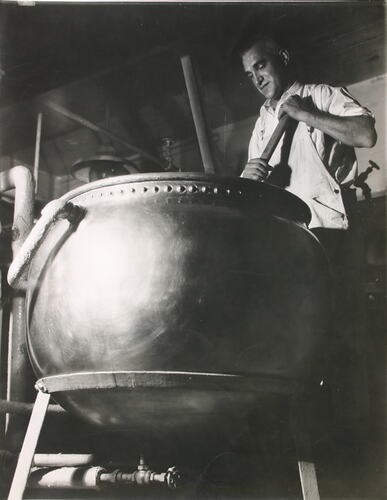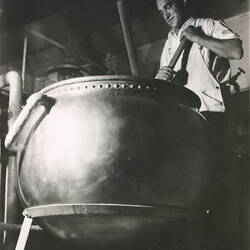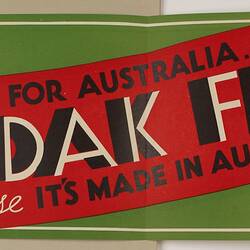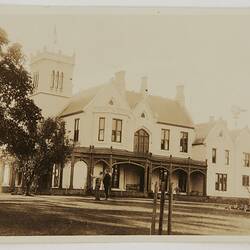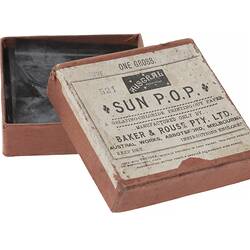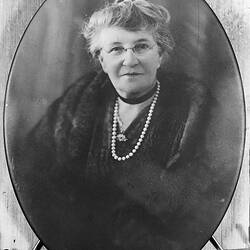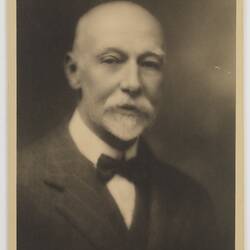Summary
Black and white contact print photograph of the interior of the Kodak factory in Abbotsford, Victoria, 1930-1960. A man is using a wooden paddle to stir photographic emulsion in a copper jacketed silver kettle, during the manufacturing process at Kodak. The emulsion was used to make photographic film and paper.
Copper jacketed pipes carried steam [on left, lagged] and other pipes carried chilled water into this manufacturing area. Staff could adjust the temperature in the emulsion kettle by turning the cold water tap on and off. When ready, the emulsion was run off down into containers which held about 8 pounds of emulsion. The containers sat on weighing scales and the operator used the scales to know when the containers were full. Initially these containers were ceramic crocks, which were called 'emulsion jars', but from the 1950s, when the factory moved to Coburg, stainless steel cans were used. The term 'emulsion jars' remained in use even after stainless steel cans were introduced. After the late 1950s when manufacturing moved to the new Coburg factory, the kettles were made of stainless steel instead of copper. Wooden paddles were used from about the 1930s to 1960s, but because wood absorbs solutions and contaminates emulsions, wooden paddles were phased out.
Once it was ready, the emulsion was stored under refrigerated conditions in the mixing and commissioning areas of the factory. In the melting area the emulsion went to a holding kettle and then through rubber lines to the coating department where paper was coated with the emulsion using a dip coating technique - this was done with a trough through which paper moved. Later the dip coating process was replaced with hopper coating for more precise and simultaneous multiple coatings. This was all done in total darkness at high speed.
There were about 50 emulsion kettles of various sizes in use in the emulsion manufacturing process at the Kodak factory, in both the Film Coating and the Paper Coating buildings. This included approximately 5 used in 'experimental finishing', 3 in 'experimental mixing', 4 in 'production mixing', 4 in 'production finishing', 6 in 'paper melting', 6 in 'film melting', 6 used as 'holding kettles' for film, and 2 used in 'glass plate manufacturing'.
Kodak manufactured and distributed a wide range of photographic products to Australasia, such as film, paper, chemicals, cameras and miscellaneous equipment. Its client base included amateur and professional photographers, as well as specialist medical and graphic art professionals who used photography, x-ray and other imaging techniques.
This photograph is part of the Kodak collection of products, promotional materials, photographs and working life artefacts collected from Kodak Australasia in 2005, when the Melbourne manufacturing plant at Coburg closed down.
Description of Content
Man in overalls stirring a large kettle with a wooden paddle. Pipes are visible to the left of the kettle, and a lamp is hanging at left rear. The kettle is sitting on a stand, with a pipe and tap underneath.
Physical Description
Black and white contact print photograph with a black border. A negative number is written in reverse on the bottom border, '3497a'
More Information
-
Collection Names
-
Collecting Areas
-
Acquisition Information
Donation from Kodak (Australasia) Pty Ltd, Ms. Kate Metcalf - Kodak (Australasia) Pty Ltd, 2005
-
Acknowledgement
Courtesy of Kodak (Australasia) Pty Ltd.
-
Place & Date Depicted
Kodak (Australasia) Pty Ltd, Abbotsford, Greater Melbourne, Victoria, Australia, 1930-1960
Former Kodak executives Ed Wood and John Mitcham provided the information on this photograph. They both worked as chemists at Kodak prior to their management roles. -
Organisation Depicted
Kodak (Australasia) Pty Ltd, Abbotsford, Greater Melbourne, Victoria, Australia, 1930-1960
Former Kodak executives Ed Wood and John Mitcham provided the information on this photograph. They both worked as chemists at Kodak prior to their management roles. -
Format
Photograph - Contact Print, Black & White
-
Inscriptions
Back, pencil, bottom middle: 'COPPER JACKETED SILVER KETTLE / EMULSION KETTLE - ABBOTSFORD'
-
Classification
Manufacturing & industry, Photographic products, Factory interior views
-
Category
-
Discipline
-
Type of item
-
Image Dimensions - Photograph
202 mm (Width), 255 mm (Height)
-
Keywords
Factories, Kettles, Manufacturing, Photochemicals, Photography, Making History - Kodak Collection
